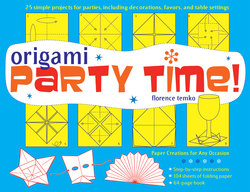Читать книгу Origami Party Time! Ebook - Florence Temko - Страница 7
На сайте Литреса книга снята с продажи.
ОглавлениеFAQ (Frequently Asked Questions)
Why fold paper?
Many people find pleasure in the folding process itself by following diagrams, while others can’t wait to achieve the result. Still others enjoy the challenge of inventing entirely new designs and some paperfolders like to teach origami to friends or in schools and libraries.
What is the history of paperfolding?
“Origami” is a Japanese word consisting of ori meaning to fold, and gami meaning paper, which means folding a piece of paper into a recognizable object without any cutting or gluing. The word has slipped into the English language because paperfolding has spread from Japan, where it is part of the culture. It is known that paper has been folded in Japan since the twelfth century for ceremonial purposes and that in the sixteenth century, paper began to be folded for decorative use and entertainment.
Records show that paper was folded in Europe in the fourteenth century. In the sixteenth and seventeenth centuries, it was common practice to fold square baptismal certificates in set patterns.
The kind of recreational origami now popular in Asia and Western countries began in the late nineteenth century, but received its greatest impetus in the latter half of the twentieth century. Akira Yoshizawa in Japan, Lillian Oppenheimer in the United States, and Robert Harbin in England were prominent forces in bringing origami to the attention of the general public.
Is origami creative?
Paperfolders constantly create new models. Once you know some of the basics you may begin to create your own simple decorations or complex sculptures. They may be variations on existing models or they may be entirely new. Some may appear in just minutes, like a doodle, while others may be so complex that they take months to design and hours to reproduce.
What are the creative developments?
Until recently origami was regarded as a craft for children and for traditional folding for Japanese rituals. This has changed in the past few years as paperfolders have taken origami into many areas beyond the pleasure of practicing it as a hobby. They constantly create new models with as few as five creases or perhaps hundreds. Their creators seem to have an artistic inclination, a mathematical or scientific mind.
